Animation Series Production Note (March 2021)
Good Life with Books (December 2020)
Interview Archive
AERA (April 2021)

In commemoration of "JOESTAR The Inherited Soul", the production notes of the successive "JoJo Anime" series have been released!
"How was" the JoJo Anime "made?" The answer will be delivered in a series of four times, with the testimony of the main staff, including Naokatsu Tsuda, who was the director in all seasons. The burning JoJo love of successive directors and producers explodes!
Interview
Vol. 1
Confronting the talent of Hirohiko Araki as a team! The creators who ran through the JoJo anime
The anime adaptation started with “This is a difficult task”
When he was approached by an anime-related company about making a TV anime, Hiroyuki Omori, a producer at Warner Brothers Japan, was worried for a while that, “This is a difficult task.” Although JoJo is one of the biggest series in Japan, the original manga started in 1987. In the early days, Hirohiko Araki drew characters in a gekiga style that was full of machismo. It was very different from modern trends in character design. Omori wondered if people who weren’t familiar with JoJo would be able to accept these designs. However, he decided to go ahead with the anime adaptation. He says, “There was the problem of what to do with the design, but the power of the work itself has not faded, and above all, I am a big JoJo fan myself, so I decided to take on the challenge despite the difficulties.” After getting Shueisha’s consent, he immediately started to choose a studio.
Naturally, a studio that could draw JoJo would have to be one that “could draw powerful muscle movements.” Therefore, Omori turned his attention to David Production, which was descended from Gonzo, a studio that had created numerous works in the past. At the time, David Production was still a newly established studio, but their work on the anime for the “Tatakau Shisho” series, which is also a JUMP property like JoJo, showed powerful linework and careful animation. Omori was convinced, “I can let them handle this,” and approached them.
Challenging Hirohiko Araki’s talent as a production team
When David Production’s producer Nobutaka Kasama received news of the anime adaptation, he came up with the secret plan of having multiple directors. “To be honest, I thought it would be difficult for a single director to take on Araki’s extraordinary talent, so I decided to have more than one director, which is unusual for a TV animation project, and challenge him as a team.”(Kasama) The task fell to Naokatsu Tsuda and Kenichi Suzuki. Although there is a slight difference in the way they are credited, with Tsuda serving as “director” and Suzuki as “series director,” they essentially collaborated on all aspects of the production.
Kasama explained why he chose Tsuda and Suzuki: “Tsuda is a good comedic director, and Suzuki is a good action director. I thought that by working together, we would be able to capture both the strength and the fun of the original manga.” In fact, Tsuda also said, “I’m a JoJo fan myself, but if I had been asked to make the anime by myself, I might have refused. But since I was working with Mr. Suzuki, I thought we might be able to do it. When I think about it now, it’s more like the folly of youthful passion. I wasn’t afraid of anything (laughs).” On the other hand, Suzuki said, “I didn’t feel any particular pressure, and the joy of being involved with JoJo, which I love, was greater than anything else. It’s a big title, but rather than be controlled by the opinions of the people around us, we were going to make our own JoJo.”
The core members of the team were Omori and Kasama, the producers, and Tsuda and Suzuki, the directors. Coincidentally, all four were huge JoJo fans. The respect for the original manga that can be felt from every corner of the film is perhaps a natural result of this lineup. Yasuko Kobayashi joined as series composer at the recommendation of the editorial department, and then, with the further addition of Yasufumi Soejima as visual director, the JoJo anime was finally ready to get going.
Make it “JoJo” not “JoJo-like”
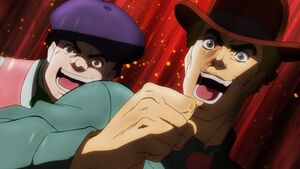
The first aim that Producer Omori discussed with the production team was to “make JoJo.” Not something “JoJo-like” or “JoJo-style,” but JoJo itself. Tsuda and his team read the original manga again and again until their copies were worn out, writing as many elements and characteristics of JoJo as they could think of on the whiteboard. They came up with everything from easy to understand things like “onomatopoeia” and “unique posing” to impressions like “I feel refreshed after reading” and “the battles are difficult.” At the end of the process, they sorted through all of it, and Kasama concluded, “If we follow the usual methods of creating animation, we’ll end up with ‘JoJo’s Ordinary Adventure.’ JoJo has to be a ‘bizarre adventure.’ If you think about it, the answer was in the title from the very beginning.”
In this way, everyone agreed to pursue the complete reproduction of all elements, including the onomatopoeia. The rules established through this meeting were later distributed to all the staff involved in the JoJo anime, and became a sort of “bible” for the rest of the series.
Hook the viewers in the first three episodes!
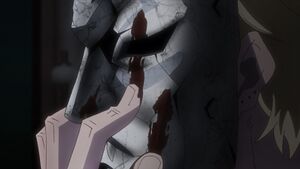
When the JoJo anime first began, there was no guarantee that it would have four seasons produced. If the first season did not achieve a certain level of success, there would be no second season, so the producer Omori focused especially hard on the first three episodes.
JoJo has a strong image of “stand battles,” and the third part of the original manga, “Stardust Crusaders,” in which stands were introduced, won many fans. For this reason, the question of how to deal with the first part of the original manga, “Phantom Blood,” which tends to be considered simple, was a major issue. Because of this, Omori tried to immerse the viewers in the world of JoJo, and so the animation staff depicted everything up to the first climax in chapter 17 in those first three episodes. Usually, one episode of an anime is equivalent to three or four chapters of a manga, so you can see how drastic the structure was. According to Omori, “I wanted to get the audience hooked on the story by making it a roller coaster ride.”
This strategy proved successful, and it was received favorably by many fans. Omori, who had been following the reactions on social media in real time, recalls, “I was really relieved, thinking we might be okay for a while.”
Raising the quality with the strongest team for the popular “Stardust Crusaders”!
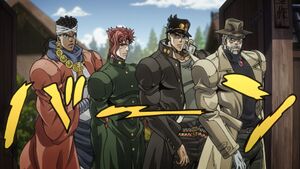
With the popularity of the first season, the production team moved on to producing the second season, “Stardust Crusaders,” (Part 3 of the original manga) as soon as the broadcast ended. The biggest draw of the second season is the depiction of fierce battles between the stands, and it is one of the most popular and vital parts of the series. For this reason, the number of drawings was increased compared to the first season, and a new action director was brought in to improve the animation. In terms of direction, Toshiyuki Kato, who played a central role in the first season, was appointed as the new chief director, establishing a more stable direction system.
The 48 episodes, the longest of the four seasons, were completed with consistent quality from start to finish, and the “dynamic beauty of muscles” that the team had been seeking since the first season matured into a completed form.
These silhouettes are familiar to many JoJo fans.
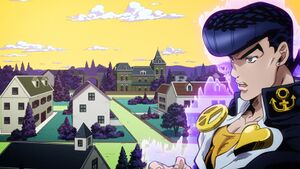
The third season “Diamond is Unbreakable” (Part 4 of the original manga) is a unique work and a complete change of direction In a change from the second season, which was a road movie, travelling all the way to Egypt from Japan, the third season is set in a small town called Morioh. Kato, who replaced Suzuki after he left JoJo to direct another film, held another brainstorming session with the team in order to accurately understand the style, which was different from anything else in the series up to this point.
“Up until the third part, the purpose of the story was clear, but in the fourth part, it was difficult to know where the goal was. In that sense, it’s quite unique, so we had a thorough discussion about the direction we would go with it.”(Kato)
As a result, they took various creative measures, such as inserting a bizarre scene of the last boss, Yoshikage Kira, at the beginning of the season, and they boldly reconstructed the original manga without losing the charm of the story.
With a new director, the series evolves even further in the fourth season, “Golden Wind” (Part 5 of the original manga)
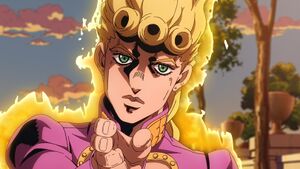
Kato, who directed the third season, left the JoJo anime to direct another project. With the loss of both Suzuki and Kato, who had been the core of the JoJo series since the first season, Tsuda used his connections to find new talent and persuaded Yasuhiro Kimura and Hideya Takahashi to become the new directors. Tsuda firmly stated, “My greatest achievement in Part 5 was bringing in Mr. Kimura and Mr. Takahashi as the directors and Takahiro Kishida as character designer.”
The two new directors had no experience with the JoJo anime, but they were each able to make full use of their talents. “At first I was worried about whether I could draw JoJo storyboards, but it turned out that I had more freedom than I thought, and I was able to work freely.” (Kimura) “Mr. Kimura and I have very different personalities, and I think we ended up with a series where our personalities really came out.” (Takahashi)
Tsuda’s theme for the fourth season was “Renaissance (Return to the Origin),” a reference to Italy where the story is set. His goal was successfully achieved as both directors went back to the roots of the JoJo anime, and the meticulous location scouting in Italy also brought a new wind to the series. This season is the culmination of Tsuda’s work on the JoJo anime, and currently its highest achievement.
What is the “inherited golden soul” of the JoJo anime?
The JoJo anime adapted an epic drama spanning 63 volumes of manga into a total of 152 episodes over a period of about 7 years. While some staff members have been involved in all parts of the series, including director Naokatsu Tsuda, series composer Yasuko Kobayashi, and sound director Yoshikazu Iwanami, there are many staff members who have left the production or joined along the way. While the JoJo anime has a “bible” that it follows, the visual concept is renewed with every season. The production team that continues to renew itself and move forward is just like the “inherited golden soul.” We hope that it will continue to evolve and be passed on to new generations.
Interviewing and writing by Daisuke Okamoto
Vol. 2 An in-depth analysis of “What is ‘JoJo’?” What are the thoughts behind the complete re-creation of the anime?
Recreating the original manga with the concept of “Study JoJo scientifically”
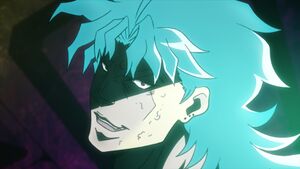
The request from producer Hiroyuki Omori of Warner Brothers Japan for the production of the JoJo anime was very simple: “Make JoJo.” In response, the director, Naokatsu Tsuda, came up with the slogan, “Study JoJo scientifically.”
He picked out all the elements that made the original JoJo manga unique and searched for ways to reproduce them in animation. He thoroughly recreated unique onomatopoeic sounds such as “Memetaa” and “Gogogogo,” as well as the unique poses, and theatrical dialogue such as “I’m impressed by that! I admire you!” On top of these, he also replicated the use of motion lines and frame layout direction in the animation.
Toshiyuki Kato, who has been directing since the first season, said, “In order to create an eerie atmosphere, there are many depictions of fog, smoke, and other unidentifiable gases swirling around in the original manga. Normally, this would have been done with CG, but we recreated it by hand, just like the original manga. In addition, when we wanted to express the disturbance of the characters, we used suspenseful techniques such as darkening the entire face with tones and illuminating only the eyes, just as in the original manga.” The staff’s attention to detail can be seen everywhere.
The “special scene coloring” is the best part of the anime
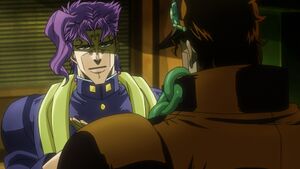
One notable visual effect is a color expression called “special scene coloring” or “special cut coloring.” As JoJo fans know, there is no fixed color scheme for JoJo. It is quite common for the same character in a color manuscript drawn by Hirohiko Araki to change color drastically from one time to the next, and the fact that he is not bound by a set color scheme is one of the things that makes him unique.
However, unlike manga manuscripts, which are usually drawn in black and white, animation is always in full color. It is not possible to change the colors with every scene. Therefore, Tsuda and his team decided on a basic color scheme that would serve as the overall base, and then adopted “special scene coloring” and “special cut coloring” to change the colors based on developments in the story. These colors are used when the character’s emotions are greatly shaken, or when the story reaches a climax, and they function effectively as accents. It is a concept that takes full advantage of the characteristics of animation, and was retained as a major strength until the fourth season.
Character designs that seek the median of fan’s imagination
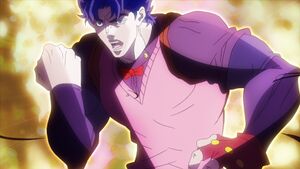
The character design was a particular point of trial and error in the visual construction of the first season. The characters drawn by Hirohiko Araki in the early days were all muscular and had a drawing style similar to gekiga. It is hard to say that this is in line with modern trends, so the challenge was how to bridge this gap. The production team created character designs that were closer to the mental image of the fans by finding the median value of the character designs from the third to fifth parts of the original manga, since those are the character designs that most JoJo fans imagine, and then bringing that back to the first season. The characters created in this way are generally mild and casual, while retaining the strong atmosphere of the early Araki characters.
From the 19th century to the present day! Art in Transition
As the era and setting of the JoJo series changes drastically from one part to the next, the art and setting work took a lot of effort. The first season, “Phantom Blood,” is set in England at the end of the 19th century, and “Battle Tendency” is set in America and Europe before World War II. These were not depicted in a realistic way in the original manga, so in a sense they were depicted as fantasy in the anime as well. The second season, “Stardust Crusaders,” however, takes place in the 1980s in various countries and regions from Japan to Egypt. Not only the architecture, but also the ethnicity and clothing of the people who come and go are diverse, so the burden on the art team, as well as the sub-character designers, was considerable.
The team was also particular about props. For example, Suzuki, who was in charge of the script and storyboard for episodes 37-38 “The Guardian of Hell, Pet Shop,” speculated that the Porsche model in the original manga might be a limited production model commonly known as the Yellow Bird, and he incorporated that into the settings. “The enemy stand at this time was a bird, and a Porsche was running into it, so I thought that perhaps Mr. Araki had a Yellow Bird in mind at the time. Well, I’m completely imagining it (laughs).” (Suzuki) Honestly, there was no need to think so hard about a car that only appeared in a few panels in the original manga, but that is the attention to detail that love for JoJo can create.
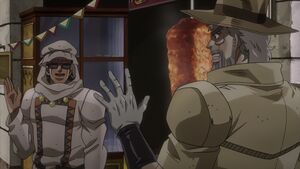
The third season, “Diamond is Unbreakable,” is a complete change from previous seasons, and is set in the fictional town of Morioh from start to finish. Kato, the director, created a precise map of the town based on the original manga, and calculated the route to each character’s house and school, as well as the time required to get there. “I think Morioh Town is the other main character of Part 4, so I wanted to make it feel as real as possible. I spent a lot of time creating the town in order to emphasize the contrast between the scenery of rural Japan that everyone is familiar with and the heinous murders that are happening behind the scenes.” (Kato)
The fourth season, “Golden Wind,” is set in Italy in 2001. General director Tsuda and directors Yasuhiro Kimura and Hideya Takahashi traveled to Italy in July 2017 for location scouting. Kimura said, “Our goal from the beginning was to make it easy for viewers to make a pilgrimage to the holy places,” and true to his word, the fans managed to find most of the places that appear in the series. The results of this meticulous location scouting work are captured in the film, giving viewers the feeling of having traveled all over Italy with Giorno and his friends.
The establishment of “JoJo-ism” in drawing
When producer Nobutaka Kasama of David Production first heard about the JoJo anime project, he worried, “How many animators will be able to work with this design?” It was a big challenge for the studio. Although David Production is a studio that excels at creating strong images, they had never created a work with such a clear emphasis on muscles and skeletons. Kenichi Suzuki, who served as the series director for the first season, looking back on the situation at that time, said, “When it comes to the drawings, I had a clear image of the finished work from the beginning, but in reality, I had to get used to it as I drew it.”
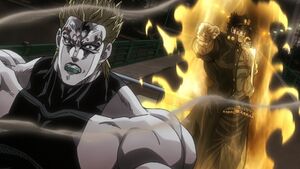
Kato also said that he paid particular attention to the sense of weight in the drawing work in the beginning. “In the rugby scene in the second episode, there is a scene where Jonathan drags three players along but does not stop moving forward, which is intended to give the impression that Jonathan has grown into a powerful young man. However, Jonathan is only human and his physical strength is fundamentally different from that of Dio, who later becomes a vampire and transcends humanity. In other words, it is necessary to show the limits of humanity at the same time, and in order to do so, it had to express the weight of carrying three men on his back. The ‘swell’ created by the high load being applied to various parts of his body is very important, and I remember giving very detailed instructions on how to fix it.” (Kato)
In this way, by carefully communicating the concept for each shot, the know-how gradually accumulated, and the drawing gradually stabilized. Animator Shunichi Ishimoto has been in charge of drawing since the first season. “The JoJo series is basically characterized by dense drawings, so at first we were just drawing through trial and error, but soon there was a ‘battle of density’ among the drawing team,” he says of the drawing situation at the time.
Character acting is similar to “stage” acting?!
The acting for the characters in JoJo is not necessarily bound by common sense. In our daily lives, we don’t have the chance to pose in a unique way, nor do we have the chance to say lines like, “Do you remember how much bread you have eaten in your life?”
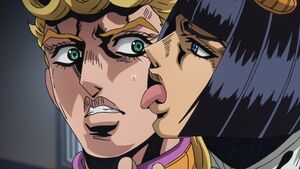
So the character acting in JoJo is more like theater. Suzuki says, “While there are rules regarding the placement of characters on stage and light sources, we sometimes deviate from them in order to maximize the appeal of Mr. Araki’s best panels. Suddenly, the lighting is changed, or a character is put in the spotlight. It’s like ‘Mie’ in Kabuki.” Kato refers to this as “stage acting,” and it is clear that they share the same image, even if the words are different.
On the other hand, Tsuda describes the battles in JoJo as “professional wrestling.” “In fact, JoJo’s characters are rarely worried. When professional wrestlers get into the ring, they don’t worry about why they’re fighting. They just do their best to make it fun and easy to understand for the audience with their microphone performance and exaggerated gestures. It’s the same with JoJo’s battles. By presenting what you’re going to do and then how it turned out, it makes the battles more interesting. If we prioritize the anime’s sense of showiness and speed, we’ll lose the charm of JoJo’s battles. That’s why I compared it to professional wrestling.” (Tsuda)
In Tsuda’s analysis, the real pleasure of JoJo’s battles is the groove that is created when the tempo and rhythm of long spoken lines, as well as the action, and characterization all come together, and that is what the anime is based on.
Interviewing and writing by Daisuke Okamoto
Vol. 3 Balancing a high level of both speed and emotion Demystifying the well-crafted composition and direction!
Clearly define the theme for each episode
The most important thing to keep in mind when working on the scenario was to make it clear what each story was about. Once the theme of each episode was clear, that would inevitably determine how it should be directed. The line producer, Nobutaka Kasama, made the assignments according to the aim of each episode, keeping the individuality of the director in mind rather than just rotating through them. Naokatsu Tsuda was for comedy and daily life, Kenichi Suzuki for action, and Toshiyuki Kato for highly dramatic episodes. On the other hand, the directors had various thoughts and feelings about the masterpiece of JoJo.
“Since we were entrusted with the original manga, we couldn’t just twist it to suit our own needs, so we wanted to somehow re-experience Mr. Araki’s ideas. The book 'Hirohiko Araki’s Strange Theory of Horror Movies' (Shueisha Shinsho), which was published right around the time of pre-production, was very useful. I was able to understand that this episode was based on this movie, and that this is what he wanted to do, and I feel like I was able to better determine the direction of the animation.” (Naokatsu Tsuda)
“I tried to trace what Mr. Araki was thinking at the time of writing. Through the movies he was watching and the music he was listening to at the time, I was able to trace his thoughts in my own way. The finished product was already out in the world in the form of manga, but my biggest mission in expressing JoJo was to feel the feelings behind it.” (Kenichi Suzuki)
“The original manga is very powerful, so I wanted to make the most of that to the degree that I could. Personally, I was moved by the scene in Part 4 where Hayato Kawajiri wishes, ‘God, please let me kill people.’ I felt that there was no other shonen manga that could make an elementary school student say such a thing, and I definitely wanted to direct that scene myself.” (Toshiaki Kato)
“I joined the project starting with Part 5, and at first I was a bit confused about how much I should try to match the way things had been expressed before, but once I started working on it, I realized how free I was. It made me realize all over again that JoJo is a work with great capacity.” (Yasuhiro Kimura)
“The main theme of Part 5 is how young people living in despair should go on living, so I was always conscious of the keyword ‘sadness.’ I tried to bring out the mature side in my own way.” (Hideya Takahashi)
The first season is a roller coaster that turns into a water slide?!
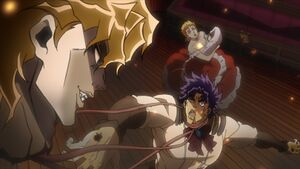
Initially, the production team wanted the first part of the original manga, “Phantom Blood,” to run for one season and the second part, “Battle Tendency,” to run for two seasons. However, the producer, Hiroyuki Omori, requested that the series be broadcasted in two seasons together. The final result was 26 episodes instead of 24, which was a rather drastic strategy. Omori said, “I thought that by seamlessly broadcasting the first and second parts all at once, people would feel the impact. They thought they were on a roller coaster, but before they knew it, they were on a water slide (laughs).” For “Phantom Blood,” in particular, the 44 chapters of the original manga were turned into 9 episodes of anime, which means that each episode of the anime contains almost 5 chapters of the original manga.
What is noteworthy is that despite running through the story at such speed, almost no stories were omitted. This can be said to be the result of the efforts of the writers, led by Yasuko Kobayashi, who worked on the series composition. In any case, it is this sense of speed that attracted many viewers and opened the door for the production of the next part.
The addition of original scenes increased the road movie feel in the second season, “Stardust Crusaders”
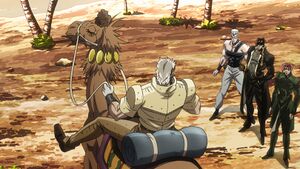
In contrast to the first season, which emphasized speed, the second season, “Stardust Crusaders,” was able to have a much more relaxed structure, which allowed the audience to fully enjoy the powerful stand battles unique to the third part of the original manga. The scenario as a whole reproduces the original manga at a very high level, but there are also many scenes that are original to the anime, which increases the “road movie” feel of the journey to Egypt.
In particular, in episode 25, “Iggy the Fool and Geb’s N’Doul, Part 1,” a scene has been added where all six members of the Joestar group take a group photo. This photo was displayed on Jotaro’s desk in the fifth part of the original manga, but it was not clear when it was taken. Tsuda said, “This was the only timing I could think of, so I consulted with Mr. Suzuki, who was in charge of the storyboard and direction, and he put it in.”
Speaking of original scenes, episode 18, “The Sun,” is also impressive. In the original manga, it is a comedy episode that ends after only two chapters, but in the anime, it was composed as one episode. As a result, more than half of the scenes are original scenes, and Tsuda, who worked on the scenario and storyboard, was able to demonstrate his impressive sense for comedy in this episode.
The composition shines best in the third season, “Diamond is Unbreakable”
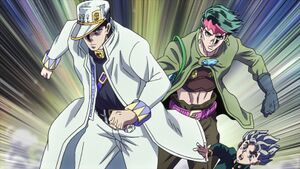
The third season, “Diamond is Unbreakable,” (Part 4 of the original manga) has the most dynamic structure in the anime series, which is clearly shown from the beginning of the first episode, “Jotaro Kujo! Meets Josuke Higashikata.” The horror of a murderer’s crazy breakfast scene is shown against the background of the cheerful MC of Morioh Radio. It suggests the existence of the last boss, Yoshikage Kira, who only appears in the latter half of the story in the original manga, while also beautifully expressing the theme of the fourth part of the original manga, which is abnormal scenes hidden in the shadow of peaceful everyday life. It is an excellent restructuring of the original story.
Kato, who served as the series director for the third season, said, “Unlike the previous stories, the fourth part does not end with the main character directly defeating the last boss, but with all the characters working together to defeat him, or more specifically, the town of Morioh town itself is structured to bury the murderer, Yoshikage Kira. In order to achieve a suitable ending, we had to pay attention to the atmosphere of the town and the depiction of the residents.” Tsuda also said, “I think the fourth part of the series was the most successful in terms of composition. We knew from the beginning that Kira Yoshikage was the final boss, and the whole story takes place in one town, so we were able to use him to our advantage.” From the frequent use of Morioh Radio to the cameo appearances of characters who appear in the latter half of the season, this was a season in which the exquisite composition was on full display.
The fourth season, “Golden Wind,” is full of original scenes that tickle the fan mentality
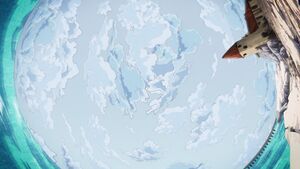
The most significant aspect of the fourth season, “Golden Wind,” (Part 5 of the original manga) is that it emphasizes the team battle more than the original manga. In the original manga, the names and appearances of the members of the assassin team are revealed in the order in which they appear as assassins, but in the anime, the faces of the entire assassin team are revealed in episode 10, “Hitman Team.” Furthermore, by depicting them eating at a restaurant, it is clear that they are also working as a team, just like Giorno and the others. As the assassin team is very popular among the fans of the original manga, the addition of many original scenes is a great service to the fans, and at the same time, it is effective in clearly showing the three-way battle of the fourth season. On the other side, moving up Mista and Abbacchio's past episodes and adding a past episode for Fugo allowed Giorno’s side to feel a sense of unity as a team early on.
Kimura, who served as the director of the 4th season, commented on this point: “The assassin team is very popular among the fans of the original manga, and they are very attractive because they are determined people. They are not attacking on their own, so I hoped that by portraying them as a team, I could convey their conviction.”
In episode 28 “Beneath a Sky on the Verge of Falling,” one of the most famous scenes in the series, Narancia is distraught over the death of Abbacchio, and the entire B part of the episode is used to recreate the scene in a way that greatly expands on the original manga. Director Takahashi, who was in charge of storyboarding and direction, said, “In the last shot of this part, there is a whole flower blooming on the ground where Abbacchio is lying. When Narancha died, Giorno hid his body with plants. But in the original manga, there’s no description of what he did to Abbacchio. I’ve wondered about that since I was in high school (laughs). I thought Giorno would have done the same thing for Abbacchio, so I added the final shot,” he said, sharing the story behind the famous scene.
Interviewing and writing by Daisuke Okamoto
Vol. 4 The culmination of the staff and cast’s love for JoJo! From the hottest theme song to the harsh dubbing process
The first theme song chosen was “ROUNDABOUT”
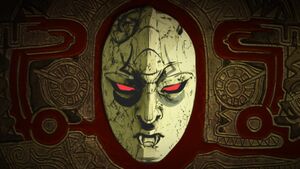
The ED theme song for the first season, “ROUNDABOUT,” was decided upon as the result of an exchange the anime side had with Hirohiko Araki while they were working on creating a new theme song.
Producer Hiroyuki Omori of Warner Brothers Japan, who is in charge of the music, had this to say about that exchange: “At first, I wanted to decide on the OP theme, so I proposed some sample songs based on rock to Mr. Araki. But the direction was different from what he had imagined, so I asked him what songs were close to his image. He suggested ‘ROUNDABOUT.’ However, it was quite difficult to make an original progressive rock song like this, so we decided to ask for permission to use ‘ROUNDABOUT’ and use it as is.”
After that, Omori suggested that it would be more appropriate as an ED theme rather than an OP theme, and with that the basic direction that later ED themes would follow was established. The ED themes are chosen based on the concept of “songs that Hirohiko Araki was listening to a lot at the time of writing” or “songs that are close to the image of each part of the original manga.”
The sound director, Yoshikazu Iwanami, who is a member of the generation that was listening to music when Yes became a hit, was surprised to hear that “ROUNDABOUT” had been chosen as the ED theme. At the same time, he wondered if it could be used as background music, and strongly suggested to the director, Naokatsu Tsuda, to make the ED video in such a way that the ED could be played from anywhere. As a result, in the first season, they adopted a special style where “ROUNDABOUT” would be played as background music, and then it led directly into the ED. According to Omori, “When the first season ended, Mr. Iwanami happily reported to me that he had included all the parts of the song. (laughs)” He had been able to use all eight and a half minutes of the original song without wasting any of it.
The OP theme is a 70’s style anime song
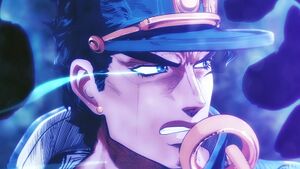
In contrast to the ED theme, which featured fashionable Western music, it was decided that the OP theme would be a masculine 70’s style anime song. The memorable first OP theme “JoJo ~That Blood’s Destiny~” was composed by Kohei Tanaka, a veteran anime song composer. “When I went to Mr. Tanaka to ask for the song, he said ‘Omori-kun, you made the right call, coming to me for this.’ (laughs)” Following the example of this song, each OP theme would be an original Japanese anime song that matched the taste of each part. In addition to the regular OP themes, a special OP theme related to Mondatta called “Evil Concerto” was created for the second season of “Stardust Crusaders,” and a variety of highly addictive and famous songs were born.
One of the most talked about aspects of the OPs is the way that the animation changes as the story progresses. In particular, in episode 47 of the 2nd season, “DIO’s World, Part 3,” Dio uses the power of “The World” to stop time, which must have shocked many fans. Regarding this trick, Omori said, “It was an idea from Kamikaze Douga, who handled the OP video. During the presentation, Junpei Mizusaki, the president of the company, suddenly said, “It’s DIO, so we just need to stop time for 9 seconds. (laughs)” He revealed that it was self-directed by Kamikaze Douga.
This direction led to the creation of the “Bites the Dust Version OP” at the end of the third season, “Diamond is Unbreakable,” in which Kira Yoshikage’s Bites the Dust is activated and the OP video plays backwards. In the fourth season, “Golden Wind,” the “Diavolo Ver.” depicted Diavolo’s King Crimson ability, and the “Giorno Ver.” depicted Giorno’s Gold Experience Requiem ability. Tsuda smiles wryly about this series of special effects in the OP. “Thanks to the trick we used in Part 3, there’s no going back now. (laughs)”
Producer Omori’s support for background music
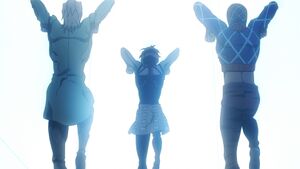
One feature of the JoJo anime is that it has had a lot of special background music produced for it. This was made possible by the fact that Omori, the production producer, also serves as the music producer. “Since I was involved from the scenario stage, I was able to prepare the music ahead of time. I was hoping that I could provide a little support for the production,” Omori said. For example, in the third episode of the first season, “Youth with Dio,” which Omori focused considerable effort on, he made long special background music tracks to match the storyboard that had been drawn ahead of time, making the film more exciting with a theatrical production style.
One of the most talked-about scenes was the 40-second dance scene in episode 7, “Sex Pistols Appears, Part 1,” of the fourth season, “Golden Wind.” During the location scouting in Italy, Kimura was so excited that he ordered Omori to do the scene, and Kimura was naturally in charge of storyboarding and directing the scene. “I forgot that I had even ordered it, and I thought, is the dance going to be this long? (laughs) In the original manga, there are only about four frames, so I had to fill in all the other frames myself, but since I’m not a dance expert, I asked a friend who is to look at the original frames. He said it looked like a Michael Jackson dance, so I spent about a month checking out videos of his live performances and music videos, and finally finished it.”(Kimura)
The harsh situation at the recording studio
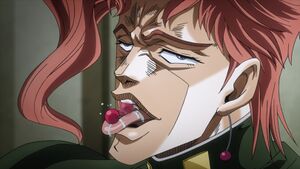
For the casting, auditions were conducted purely on the basis of whether or not the actor fit the character, ignoring factors such as name recognition and popularity. Tsuda said that the top priority for JoJo voice actors was that they had to have “sound pressure and be a good performer,” but he also took into account “having broad repertoire of skills,” and “being articulate.” There are many scenes in JoJo that stretch the actors’ voices to the limit. Looking back on the dubbing process, Toshiyuki Kato, who served as the series director for “Diamond is Unbreakable” said, “From the very first season, the dubbing of ‘JoJo’ has always been very difficult. We have to demand the maximum amount of passion and volume of voice at all times, and I end up selfishly worrying what they’ll do if they have to record another one after this. I always felt sorry for the cast members.”
However, despite the harsh conditions, many JoJo-loving cast members gathered at the auditions, and the number of JoJo-loving cast members in the booth inevitably increased. There were even some who took the initiative to lecture the confused cast members who were participating in the dubbing for the first time, saying things like, “JoJo’s lines are read with a small ‘tsu’ sound.” The producer, Nobutaka Kasama, expressed his gratitude to the cast, saying, “The original theme was to do it without changing one word of the original lines, so it was very helpful for the staff side.”
In fact, Noriaki Kakyoin’s famous “Rero Rero” was recorded 17 times (episode 9, “Yellow Temperance”). Kenichi Suzuki, the series director of “Stardust Crusaders,” is said to have asked Daisuke Hirakawa, who played Kakyoin, to “practice Rero Rero from now on” when he came to the studio for the first recording. This attention to detail is incredible. Of course, it can also be said that the cast members who responded to these orders with perfect performances were full of love for JoJo.
Creating the best sense of rhythm with final adjustments made frame by frame
After “Stardust Crusaders,” there was an attempt to use the method of recutting. In this method, the first cut which will be taken to voice recording is done with a 30-second margin, and then the final adjustment is made by cutting only a few frames between the lines. This allows for a more pleasant sense of rhythm and a tempo that does not lag even in scenes with many long lines. The accumulation of such detailed creative measures may have led to the pleasant feeling that is typical of JoJo.
What was the JoJo anime?
What did you think of the four production notes? I hope I was able to convey the strong love and dedication to the original manga in all sections of planning, scenario, video, and sound. Finally, I’d like to talk about what the JoJo anime was.
In writing this article, I interviewed the producers and directors once again, and I was struck by how everyone’s face instantly turned back to a boyish expression when they talked about JoJo. The workplace environment for animation production is much harder and harsher than we can imagine. There must have been a lot of anguish and human drama behind the scenes of a project that has run for nearly 10 years. Even so, when it comes to JoJo, the JoJo team’s faces instantly revert to those of young boys. That is what makes them so amazing, and I felt that those faces tell the whole story of the JoJo anime.
Lastly, I asked the staff I interviewed, “What is the JoJo anime for you?” Their answers varied, but I would like to note that they were all filled with an indescribable “refreshing” feeling.
─ Naokatsu Tsuda “I was inexperienced, but this work taught me everything I needed to know as a director.”
─ Kenichi Suzuki “This is the film that helped me in my life. It was definitely a turning point in my career.”
─ Toshiyuki Kato “It broadened my view of directing. It made me realize that anything is possible as long as it’s interesting and powerful.”
─ Yasuhiro Kimura “It was painful when I was making it, and I was sad when it was over. It’s such a rare work.”
─ Hideya Takahashi “The three years I spent working on JoJo were a very special experience and have become a treasure in my life.”
─ Producer:Hiroyuki Omori “I knew it was going to be a long battle, so I promised myself that I would not give up, no matter what.”
─ Producer : Nobutaka Kasama “I still remember vividly how when the second season ended, all the staff hugged each other’s shoulders and cried wildly.”
Interviewing and writing by Daisuke Okamoto
Vol. 1
荒木飛呂彦の才能にチーム戦で立ち向かう! 『ジョジョアニメ』を駆け抜けたクリエーターたち
アニメ化の幕開けは「これは難題だ」
ワーナー ブラザース ジャパンの大森啓幸プロデューサーは、とあるアニメ関連企業からTVアニメ化の話を持ちかけられた際、「これは難題だ」としばらく悩んだという。日本を代表するビッグコンテンツのひとつではあるが、なにしろ原作の発表は1987年である。とくに初期の荒木飛呂彦が描くキャラクターは劇画調でマッチョイズムに溢れており、少なくとも現代の流行の絵柄とはかけ離れていた。ジョジョを知らない層は、はたして受け入れられるのだろうかと。しかし大森は「絵柄をどうするかという問題はありましたが、作品そのものがもつパワーはけして色褪せてはいませんし、なにより僕自身が大のジョジョファンということもあって、困難を承知で挑戦させてもらうことにしました」と、アニメ化を決意。集英社からの快諾も得て、さっそくスタジオ選びに着手することになる。
ジョジョを描くことのできるスタジオとなると、当然「力強い筋肉の躍動が描けるスタジオ」ということになる。そこで大森は、かつて骨太な作品を数多く手がけていたGONZO(ゴンゾ)の流れを汲むdavid production(デイヴィッドプロダクション)に着目。当時のデイヴィッドはまだ設立したばかりの新興スタジオだったが、ジョジョと同じくジャンプ系列作品である『戦う司書』シリーズを力強い描線で丁寧にアニメ化していたことを受け、大森は「ここならば任せられるだろう」と確信し、打診に及んだという。
荒木飛呂彦の才能に、チーム戦で挑む
アニメ化の知らせを受けたデイヴィッドプロダクションの笠間寿高プロデューサーが考えた秘策は、複数監督体制だった。「たぐいまれなる荒木先生の才能を、ひとりの監督で引き受けるのは正直難しいと思ったんです。TVアニメの座組としては珍しいのですが、監督を複数体制にして、チーム戦で挑むことにしました」(笠間)。白羽の矢が立ったのは、津田尚克と鈴木健一のふたり。津田は「監督」、鈴木は「シリーズディレクター」とクレジットに多少の違いはあるものの、実質的にはすべての作業を協業する形で制作に取り掛かった。
笠間は津田と鈴木のふたりを起用した理由について「津田さんはコメディに強く、鈴木さんはアクションに強い演出家。このふたりが協力することで、原作の力強さと面白さのどちらの魅力もすくい取れるのではないかと思った」と話す。実際、津田も「僕自身もジョジョファンではありますが、僕ひとりで作れと言われていたら断っていたかもしれません。鈴木さんといっしょということで、それならできるかもと思ったんです。今思うと若気の至りというか、怖いもの知らずでしたね(笑)」と当時を振り返った。一方の鈴木は「プレッシャーはとくになくて、大好きなジョジョに携われるという喜びのほうが大きかったです。大きなタイトルですが、あまり周りの意見に惑わされることなく、僕と津田君のジョジョを作ろう」と意気込んだ。
こうしてプロデューサーの大森と笠間、ディレクターの津田と鈴木という中核メンバーが揃ったが、奇しくも4人全員が大のジョジョファン。フィルムの隅々から感じる原作へのリスペクトは、この布陣を考えればむしろ当然の結果なのかもしれない。また編集部の推薦により小林靖子がシリーズ構成として参加。さらにビジュアルディレクターとしてソエジマヤスフミが加わり、いよいよジョジョアニメは走り出す。
「ジョジョっぽいもの」ではなく「ジョジョを作る」

制作チームに対し、大森プロデューサーが最初に相談した方向性は「ジョジョを作る」ことだった。「ジョジョっぽいもの」や「ジョジョらしいもの」ではなく、ジョジョそのものを作るということ。それを受けた津田たちは、再度原作をボロボロになるまで読み込み、ホワイトボードに思いつく限りジョジョの要素や特徴を書き出していった。「擬音」や「独特なポージング」といった分かりやすいものから、「読後感スッキリ」、「バトルが難解」といった印象に至るまであらゆるものを出し尽くす。そして最後にそれらを整理していくのだが、「一般的なアニメーションの作法に則って作る限りは、どうも"ジョジョの平凡な冒険"になってしまう。ジョジョはあくまで"奇妙な冒険"でなくてはなりません。そう考えると答えは最初からタイトルにあったんですよね」(笠間)との結論に至る。
こうして「擬音」をはじめとしたすべての要素の完全再現を追い求めることで全員が一致。この会議を通じて設けられたルールはのちにジョジョアニメに関わるすべてのスタッフに配布され、以降のシリーズを通じて「バイブル」として機能することになった。
冒頭3話で視聴者を惹きつける!

ジョジョアニメは、最初から4thシーズンまでの制作が約束されていたわけではない。1stシーズンで一定の成果を得られなかった場合には2ndシーズンの制作は行われないという状況で、大森プロデューサーがとくに注力したのは冒頭3話だった。
そもそもジョジョと言えば「スタンドバトル」のイメージが強く、スタンドが登場した原作第3部「スターダストクルセイダース」で多くのファンを獲得した作品である。それだけに、ともすれば地味に思われがちな原作第1部「ファントムブラッド」をどう扱うかは大きな課題だった。そこで大森は、視聴者が冒頭3話でジョジョの世界観にどっぷりと浸かってくれるように心掛け、アニメスタッフは最初の山場となる原作17話までを冒頭3話で一気に描き切った。通常アニメの1話は漫画の3、4話分に相当するのが一般的だから、これがいかに思い切った構成かがよく分かるだろう。大森曰く「ジェットコースターのような展開にすることで、視聴者に夢中になってもらいたかったんです」とのこと。
この展開は功を奏し、多くのファンに好意的に受け止められた。リアルタイムでSNSの反応を追っていた大森は「これでひとまず大丈夫かもしれないと、心からホッとしました」と述懐する。
人気の「スターダストクルセイダース」は 最強布陣でクオリティアップ!

1stシーズンの好評を受け、放送終了後すぐに制作チームは2ndシーズン「スターダストクルセイダース」(原作第3部)の制作へ移行。2ndシーズンはスタンドによる激しいバトル描写が最大の魅力で、シリーズでも屈指の人気を誇る絶対に落とせない部。そのため1stシーズンと比べて作画枚数を増やし、新たにアクション監督を迎え入れるなど作画面での強化が図られた。また演出面でも、1stシーズンで中心的な役割を果たした加藤敏幸が新たにチーフ演出を務め、より安定した演出体制を確立。
こうして4シーズン中最長となった全48話を、終始安定したクオリティで駆け抜けることに成功した。1stシーズンから追い求めていた「筋肉の躍動美」は円熟味を増し、フィルムとしてひとつの完成形を迎えたと言える。
3rdシーズン「ダイヤモンドは砕けない」(原作第4部)は 異色作ゆえ、ガラリと方向転換

日本からはるばるエジプトを目指すロードムービーだった2ndシーズンから一転、3rdシーズンは杜王町という小さな街が舞台となる。別作品を監督するためジョジョを離れた鈴木に代わって監督に就任した加藤は、これまでとは毛色の違う作風を正確に把握するため、再びチームでブレストを開催。
「第3部までは物語の目的がはっきりしていたんですが、第4部はゴールがどこにあるのかわかりにくいんですよね。そういう意味ではかなり特殊なので、方向性については徹底的に議論しました」(加藤)。
その結果、ラスボスである吉良吉影の猟奇シーンを冒頭に挿入するといったさまざまな工夫を凝らし、ストーリーの魅力を損なうことなく原作を大胆に再構成してみせた。
新監督を迎え、さらに進化した 4thシーズン「黄金の風」(原作第5部)

3rdシーズンで監督を務めた加藤が別作品の監督を務めることとなり、ジョジョアニメから離脱。1stシーズンから作品の中核をになってきた鈴木・加藤という両翼を失ったことにより、津田は新戦力を求めて自らのツテを駆使し、木村泰大と髙橋秀弥を口説き落として新監督に就任させる。津田は「第5部における僕のいちばんの功績と言えば、木村さんと高橋さんを監督に、岸田隆宏さんをキャラクターデザインに引き入れたことです」と言い切るほど。
こうしてジョジョアニメ未経験ながら新監督となったふたりは「最初こそ僕にジョジョのコンテが描けるのか不安でしたが、思っていた以上に自由度が高いことがわかり、ノビノビとやれました」(木村)、「僕と木村さんは個性がまったく違っていて、結果的にお互いの個性がよく出たシリーズになったと思います」(高橋)と、それぞれの才能を存分に発揮する。津田が4thシーズンで掲げたテーマは、物語の舞台であるイタリアにちなんで「ルネッサンス(原点回帰)」。両監督がゼロからジョジョアニメの原点に立ち返ることで津田の狙いは見事に達成され、さらに綿密なイタリアロケハンの成果もあって、シリーズに新しい風を吹かせることとなった。津田が手がけてきたジョジョアニメの集大成であり、現時点での最高到達点である。
ジョジョアニメ、その「受け継がれる黄金の魂」とは?
単行本63巻に及ぶ壮大な大河ドラマを、約7年間をかけ計152話で描いたジョジョアニメ。監督の津田尚克やシリーズ構成の小林靖子、音響監督の岩浪美和をはじめ、全ての部に携わっているスタッフもいる一方で、途中退場したスタッフや新たに途中参加したスタッフも少なくない。「バイブル」をベースにしつつも、シーズンごとにビジュアルコンセプトが一新されていくジョジョアニメ。新陳代謝を繰り返しながらも前進し続ける制作チームは、まるで「受け継がれる黄金の魂」そのもの。これからもさらなる進化を遂げながら、新しい世代へと受け継がれていくことに期待したい。
取材・文/岡本大介
Vol. 2
「『ジョジョ』とは何か?」を徹底的に分析アニメでの完全再現に込められた想いとは?
「ジョジョを科学する」という発想で原作を再現

ジョジョアニメを制作するにあたり、ワーナー ブラザース ジャパンの大森啓幸プロデューサーからの要求は「ジョジョを作る」というごくシンプルなもの。それを受け、監督の津田尚克が掲げたスローガンは「ジョジョを科学する」だった。
原作の特徴であり、ジョジョをジョジョたらしめる要素を全て拾い上げ、アニメーションで再現する方法を模索。「メメタァ」や「ゴゴゴゴゴ」といった独特な擬音、個性的なポージング、「そこにシビれる! あこがれるゥ!」といった舞台的な台詞回しなど、誰もがイメージするものはもちろんのこと、集中線の使用や画面内のコマ割り演出などもアニメで徹底的に再現した。
1stシーズンから演出を務める加藤敏幸は「不気味さを演出するために、原作では霧や煙のような名状しがたい気体が渦を巻いている描写がけっこうあるんです。通常であればこれらはCGで処理してしまうんですが、そこは原作そっくりに手書きで再現しています。ほかにもキャラクターの不穏さを表現したい場合に、顔全体にトーンを貼って暗くして、目だけに光を当てるといったサスペンス的手法も原作通りに取り入れています」と語っており、スタッフ陣のこだわりが随所に見て取れる。
「シーン特色」はアニメならではの醍醐味

映像演出で特筆すべきは、「シーン特色」や「カット特色」と言われるカラー表現だ。ジョジョファンならご存知の通り、ジョジョのカラーリングには決まった色が存在しない。荒木飛呂彦が描くカラー原稿は、同じキャラクターでもそのときどきによって色がガラリと変化することはよくあることで、むしろ決まった色に捕らわれないことがひとつの個性となっている。
とは言え、基本的にモノクロで描かれる漫画原稿とは違い、アニメーションはつねにフルカラー。シーンごとに色がコロコロ変化するわけにはいかない。そこで津田たちは、全体のベースとなる基本色を決めたうえで、展開に応じて色を変化させる「シーン特色」や「カット特色」を採用。キャラクターの心情が大きく揺さぶられたり展開の山場などで使用され、アクセントとして効果的に機能している。アニメーションの特性を存分に生かした発想で、大きな強みとして4thシーズンまで踏襲された。
キャラデザはファンがイメージする中央値を模索

1stシーズンのビジュアル構築において、とりわけ試行錯誤したのがキャラクターデザインだ。というのも、初期の荒木飛呂彦が描くキャラクターはみな筋肉隆々で画風も劇画に近い。現代の流行とは言い難く、このギャップをどう埋めるかが課題となった。そこで制作チームは、多くのジョジョファンがイメージするキャラクター造形が原作第3部から第5部であることから、その中央値を1stシーズンに還元することで、よりファンの心象イメージに近いキャラクターデザインを作り上げていった。こうして出来上がったキャラクターたちは、初期の荒木キャラならではの濃い雰囲気も残しつつ、全体的にマイルドでカジュアルな造形に落ち着いている。
19世紀から現代まで! 美術の変遷

部ごとに時代や舞台がガラリと変化するのもジョジョシリーズの特徴だけに、美術や設定作業も大変な苦労を伴った。1stシーズン「ファントムブラッド」は19世紀末のイギリス、「戦闘潮流」は第二次世界大戦前のアメリカやヨーロッパが舞台となるが、これらは原作でも現実に即した形では描かれていないため、アニメにおいてもある意味ファンタジーとして描かれた。しかし続く2ndシーズン「スターダストクルセイダース」となると、時代は1980年代で、日本からエジプトに至るさまざまな国と地域が舞台となる。建築物だけでなく、行き交う人々の民族や服装も多岐にわたるため、美術班だけなくサブキャラクターデザインの負担は相当なものになったという。
またプロップ(小物設定)についてもこだわっており、例えば第37-38話の「地獄の門番ペット・ショップ」の脚本と絵コンテを担当した鈴木は、原作に登場するポルシェの車種について、通称・イエローバードと呼ばれる限定生産モデルなのではないかと推測し、設定に取り入れている。「この時の敵スタンドが鳥で、そこにポルシェが突っ込んでくるので、おそらく当時の荒木先生もイエローバードを想定していたんじゃないかと思ったんです。まあ完全に想像なんですが(笑)」(鈴木)。正直なところ、原作に数コマ登場しただけの車についてここまで考察を広げる必要はないのだが、それこそがジョジョ愛がなせるこだわりだろう。
3rdシーズン「ダイヤモンドは砕けない」はこれまでとは一変して、最初から最後まで架空の街・杜王町が舞台となる。監督を務めた加藤は原作をもとに精密な杜王町の地図を作り、各キャラクターの家や学校までの通学路、所要時間など、作中で行われる移動のルートを細かく計算。「杜王町は第4部のもうひとつの主役だと思っているので、できるだけ実在感を出したかったんです。誰もが馴染みのある日本の片田舎の風景と、その裏で起こっている凶悪な殺人事件という対比を強調するためにも、町の作り込みには時間をかけました」(加藤)。
4thシーズン「黄金の風」の舞台は2001年のイタリア。総監督の津田、監督の木村泰大、髙橋秀弥らは2017年7月にロケハンのためイタリアへ渡航。「聖地巡礼をしやすくしようというのは最初から目標にしていた」という木村の言葉とおり、作中に登場するほとんどの場所を突き止めた。この綿密なロケハン作業の成果はフィルムに空気感としてしっかりと閉じ込められており、視聴者はジョルノたちとともにイタリア全土を旅行したような気分になれる。
作画における「ジョジョイズム」の確立

デイヴィッドプロダクションの笠間寿高プロデューサーは、最初にジョジョのアニメ化を聞いた際、「この絵柄を動かせるアニメーターがどれだけいるだろうか?」と不安を覚えたという。たしかにデイヴィッドプロダクションは濃い絵柄を動かすことが得意なスタジオではあるが、それでもここまではっきりと筋肉や骨格が強調された作品はこれまでに経験がなく、スタジオとしても大きな挑戦だった。1stシーズンでシリーズディレクターを務めた鈴木健一は「作画に関しては最初から明確な完成イメージはありましたが、実際には描きながらこなれていくしかありませんでした」と当時の状況を振り返る。
また加藤は序盤の作画作業はとくに重量感にこだわったと語る。「第2話のラグビーシーンで、ジョナサンが3人の選手を引きずりながらも前進をやめないというシーンがあるんですが、ここは力強い青年に成長したジョナサンの姿を印象づける狙いがあるんです。とは言えジョナサンはあくまで人間であり、のちに吸血鬼となって人間を超越するディオとは根本的に肉体の強度が違います。つまりここでは人間としての限界も同時に示す必要があり、そのためには3人の男を背負ったときの重みをしっかりと表現しないといけない。身体のあちこちに高い荷重がかかることで生まれる「うねり」が大切で、そこはかなり細かく修正指示を出した記憶があります」(加藤)。
このように、カットごとにコンセプトを丁寧に伝えていくことでじょじょにノウハウが蓄積していき、しだいに作画は安定していった。1stシーズンから作画を担当しているアニメーター・石本峻一は「ジョジョシリーズは基本的に濃い作画が特徴で、最初は手探りでしたが、作画班のあいだではしだいに「濃さ合戦」が繰り広げられていました」と当時の作画状況を語る。
キャラクター芝居は「舞台」に近い!?

ジョジョにおけるキャラクターの芝居は、必ずしも常識に縛られない。我々は日常生活のなかで作中のような独特なポージングをすることはないし、「おまえは今まで食ったパンの枚数をおぼえているのか?」といったセリフを言う機会もないのだ。ではジョジョにおけるキャラクター芝居とはなにかと言えば、それはむしろ演劇に近いという。鈴木は「舞台上のキャラクター配置や光源といったルールはありつつ、荒木先生の決めゴマの魅力を最大限に発揮するためには、ときには大きく逸脱させることもあります。突然照明を変えたりキャラクターにズバッとピンスポットを当てたり。歌舞伎でいうところの"見得"のイメージですね」と話す。このことを加藤は「舞台芝居」と表現しており、言葉は違えど同じイメージを共有していることがうかがえる。
一方で、ジョジョのバトル描写について、津田は「プロレス」と言い表している。「じつはジョジョのキャラってほとんど悩まないんです。そこはひとつのポイントで、リングに上がったプロレスラーは、なぜ自分が戦っているのかを悩んだりはしないですよね。マイクパフォーマンスや大げさなジェスチャーで、お客さんに気持ちよく分かりやすく楽しんでもらうために全力を尽くすじゃないですか。ジョジョのバトルもそれと同じで、これから自分が何をするつもりなのか、結果どうなったのかをちゃんと提示しながら戦うことで、むしろそれが旨味になるんです。アニメ的なケレン味やスピード感を優先してそこをスポイルしてしまうと、それはジョジョのバトルではなくなってしまうし、魅力も失われてしまう。プロレスに例えたのは、それが理由です」(津田)。
ジョジョにおけるバトル描写とは、長セリフのテンポや韻、アクション、キャラクター性のすべてが渾然一体となって生まれるグルーヴ感こそが醍醐味だと津田は分析しており、アニメはそれをベースに作られている。
取材・文/岡本大介
Vol. 3
疾走感と情緒感がハイレベルで両立 練りに練られた構成と演出の妙を解き明かす!
1話ごとにテーマを明確に
シナリオ作業においてもっとも意識したのは、各話ごとに「何をする話」なのかを明確にしようというものだった。各話のテーマがはっきりすれば必然的に演出の方向性も決まってくる。ラインプロデューサーの笠間寿高は、そうして導き出した各話数の方向性に応じて、コメディや日常なら津田尚克、アクションは鈴木健一、ドラマ性の高い話数であれば加藤敏幸というように、ローテーションではなく演出家の個性を念頭に置きながら割り振りを実施した。その一方で、ディレクター陣はジョジョという名作を前にさまざまな思いを抱いていた。
「原作をお預りしている以上、僕らが勝手に捻じ曲げるわけにはいきませんから、何とかして荒木先生の思想を追体験しようと思っていました。ちょうどプリプロ時期に発行された『荒木飛呂彦の奇妙なホラー映画論』(集英社新書)はすごく役立ちましたね。このエピソードはこの映画が元ネタだとか、こういうことがやりたかったんだということがよく分かって、アニメの方向性もより定まったような気がします」(津田尚克)
「執筆当時の荒木先生が何を考えていたのか。当時先生が観ていた映画や聴いていた音楽などを通じて、自分なりにトレースしていきました。漫画という形ですでに成果物は世に出てはいるんですが、その奥にある気持ちを感じ取ることが、ジョジョを表現するうえで最大のミッションでした」(鈴木健一)
「原作のパワーがすごく強いですから、そこはできる限り生かしたいという気持ちがベースにありました。個人的には第4部の川尻早人が「神様 どうかこのぼくに 人殺しをさせてください」と願うシーンにグッときて、小学生にこんなことを言わせる少年漫画はほかにないだろうと感じ、ここは絶対に自分で演出したいと申し出ました」(加藤敏幸)
「第5部から参加して、過去の表現をどこまで踏襲すればいいのか、最初は戸惑いもありましたが、いざやってみたらすごく自由で。ジョジョはそれだけ器の大きな作品なんだということを改めて感じました」(木村泰大)
「第5部は絶望の中で生きる若者たちがどう生きて行くかというのが大きなテーマになっているので、『悲哀』というキーワードはつねに意識していました。自分なりに大人な部分を出そうと思っていました」(髙橋秀弥)
1stシーズンはジェットコースターからのウォータースライダー!?

制作チームは当初、原作第1部「ファントムブラッド」で1クール、原作第2部「戦闘潮流」で2クールでの構成を希望していた。しかしプロデューサーの大森啓幸はまとめて2クールで一気に放送することを要望。最終的には24話ではまとまらず26話構成となったが、これはかなり思い切った戦略だ。大森は「1部と2部をシームレスに一挙放送することで、インパクトを感じてもらえるのではと思いました。ジェットコースターに乗っていると思っていたら、いつの間にかウォータースライダーに乗っていた、みたいな(笑)」と振り返る。なかでも「ファントムブラッド」に関しては原作44話分をアニメでは9話にまとめており、これはアニメ1話あたりほぼ原作5話が入っている計算になる。
特筆すべきは、それほどのスピード感で駆け抜けながらもエピソードはほとんど割愛していないということ。これはシリーズ構成を務めた小林靖子を中心とするライター陣の努力の賜物とも言える。ともかく、この疾走感こそが多くの視聴者を惹き付け、結果として続編制作への扉を開いたことは間違いないだろう。
オリジナルシーンの追加でロードムービー感が増した2ndシーズン「スターダストクルセイダース」

スピード感を重視した1stシーズンに対し、2ndシーズン「スターダストクルセイダース」はかなり余裕をもった構成が可能となり、そのおかげで原作第3部ならではの迫力あるスタンドバトルがたっぷりと堪能できるシーズンとなった。シナリオは全体として非常に高いレベルで原作を再現しているが、随所にアニメオリジナルのシーンも追加されており、エジプトを目指して旅をする「ロードムービー感」が増しているのもポイント。
とくに第25話「「愚者(ザ・フール)」のイギーと「ゲブ神」のンドゥール その1」ではジョースター一行の6人全員で集合写真を撮るシーンが追加されている。この写真は原作第5部で承太郎が机の上に飾っていたものだが、原作中ではどのタイミングで撮影されたかは明らかになっていなかった。津田は「このタイミングしか考えられなかったので、コンテと演出を担当した鈴木さんに相談して、それで入れてもらいました」と話す。
そしてオリジナルシーンと言えばもうひとつ、第18話「太陽(サン)」も印象的だ。原作ではわずか2話で終わってしまうコメディ色の強いエピソードだが、アニメではこれを1話として構成。結果として半分以上がオリジナルシーンとなり、シナリオと絵コンテを手がけた津田の高いコメディセンスが発揮されたエピソードとなった。
構成の妙がもっとも光る3rdシーズン「ダイヤモンドは砕けない」

3rdシーズン「ダイヤモンドは砕けない」(原作第4部)はアニメシリーズを通じてもっとも大胆な構成で、それは第1話「空条承太郎! 東方仗助に会う」の冒頭からハッキリと示されている。杜王町RADIOの陽気なMCを背景に、殺人鬼による狂気の朝食シーンが映し出される恐怖。原作では物語の後半になってようやく登場するラスボス・吉良吉影の存在を示唆するとともに、平和な日常の影に潜む異常な光景という原作第4部のテーマまでを見事に表現しており、秀逸な原作の再構成と言える。
3rdシーズンでシリーズディレクターを務めた加藤は「第4部はこれまでの話とは違い、主人公が直接的にラスボスを倒して終わるのではなく、キャラクター全員が協力して倒す、もっと言えば杜王町という町そのものが吉良吉影という殺人鬼を葬り去るという構造になっているんです。それにふさわしいラストへと向かうためにも、街の雰囲気や住人たちの描写には気を配りながら積み上げていきました」と話す。また津田も「シリーズ構成的には第4部がもっともうまくいったと思います。最初から最後までひとつの街が舞台となったことと、僕らは最初から吉良吉影がラスボスだということを知っているので、そこをいい意味で使い倒すことができました」と振り返る。頻繁に流れる杜王町RADIOをはじめ、後半に登場するキャラクターが序盤にカメオ出演するといった小ネタまで、構成の妙がもっとも発揮されたシーズンとなった。
4thシーズン「黄金の風」はファン心理をくすぐるオリジナルシーンが満載

4thシーズン「黄金の風」(原作第5部)の構成でもっとも大きな点は、原作と比べてチーム戦であることがより強調されているということだ。暗殺者チームのメンバーは、原作では刺客として登場した順に名前とビジュアルが明らかになっていくが、アニメでは第10話「暗殺者(ヒットマン)チーム」にて暗殺者チーム全員の顔が判明する。さらにレストランでの食事風景を描くことで、彼らもまたジョルノたちと同じように、チームで動いていることが分かる。原作ファンのあいだでも人気の高い暗殺者チームだけに、多くのオリジナルシーンが追加されたことはファンにとっても嬉しいサービスであり、同時に4thシーズンが三つ巴の構図であることを鮮明に映し出すという意味でも効果的だ。また一方で、ミスタやアバッキオの過去エピソードが繰り上がり、フーゴの過去エピソードも追加されたことで、ジョルノ側も早い段階でチームとしての一体感が感じられる仕掛けになっている。
4thシーズンで監督を務めた木村はこの点について「暗殺者チームは原作ファンからの人気も高いですし、覚悟が決まっている人たちなのでとても魅力的なんですよね。けして独断で襲ってきているわけではないので、そこはチームとして描くことで彼らなりの信念が伝わればいいなと思いました」と語る。
そしてシリーズ屈指の名場面として名高い第28話「今にも落ちて来そうな空の下で」では、アバッキオの死に取り乱すナランチャを中心に、原作を大幅に拡張させる形でBパート全体を使って再現。絵コンテと演出を担当した監督の高橋は「このパートのラストカットでは、アバッキオが倒れている地面に一面の花を咲かせているんです。ナランチャが死んだとき、ジョルノは彼の体を植物で隠したじゃないですか。でも原作だとアバッキオに対して何かした描写はないんですね。高校生のころからそれが気になっていて(笑)。ジョルノならきっとアバッキオにも同じことをしていたのだろうと思い、最後のカットを加えました」と、名場面の裏話を語ってくれた。
取材・文/岡本大介
Vol. 4

最初に決まった主題歌は「ROUNDABOUT」
1stシーズンのEDテーマ「ROUNDABOUT」は、オリジナルの主題歌を作ろうと動いていたアニメサイドと荒木飛呂彦とのやり取りのなかで決まった楽曲だという。
音楽を担当するワーナー ブラザース ジャパンの大森啓幸プロデューサーは、当時のやり取りについて「最初はOPテーマを決めようと思って、ロックをベースにいくつかのサンプル曲を荒木先生に提案してみたんです。でも先生のイメージとは方向性が違っていて、逆にイメージに近い曲はなんですか?と伺ったところ、提示されたのがこの「ROUNDABOUT」でした。でもこういったプログレ(プログレッシブ・ロック)をオリジナル曲で作るのはかなり難しいので、それならいっそのこと「ROUNDABOUT」の使用許諾を得てそのまま使おうとなったんです」と振り返る。
その後、OPテーマよりもEDテーマのほうがふさわしいのではないかという大森の発案からEDテーマとなり、以降のEDテーマの基本路線も固まった。EDテーマは荒木飛呂彦が「執筆当時によく聴いていた曲」、あるいは「部のイメージに近い曲」というコンセプトで統一されている。
イエスの直撃世代である音響監督の岩浪美和は、「ROUNDABOUT」がEDテーマに決まったことを知って驚くと同時に、なんとか劇伴として使用できないかと考え、監督の津田尚克に「どこからでもEDを流せるようにED映像を作ってほしい」と強く提案。その結果、1stシーズンは「ROUNDABOUT」が劇伴として流れ、そのままEDテーマへと繋がっていく特殊なスタイルとなった。大森曰く「1stシーズンが終わった時、岩浪さんが僕に「楽曲の全部の箇所を入れたから」と嬉しそうに報告してくれました(笑)」とのことで、8分半もある原曲を無駄にせずに使い切る結果となった。
場面カット1
OPテーマは70年代風アニソン
オシャレな洋楽が揃ったEDテーマとは打って変わり、OPテーマは男くさい70年代風アニソンに決定。記念すべき初代OPテーマ「ジョジョ 〜その血の運命〜」を作曲したのは、ベテランアニソン作曲家の田中公平。「田中さんに依頼にいった時は「大森君、僕のところにもって来たのはね、正解だよ」って言われました(笑)」(大森)。この楽曲をきっかけとして、OPテーマは各部のテイストにマッチしたオリジナルの邦楽アニソンに定着。また正規OPテーマのほかにも、2ndシーズン「スターダストクルセイダース」では「アク役◇協奏曲」というボインゴ絡みの特殊OPテーマが制作されるなど、中毒性の高いバラエティ豊かな名曲が数多く誕生した。
またOPで大きな話題となったのが、ストーリーの進行に合わせて変化していくアニメーション。なかでも2ndシーズン第47話「DIOの世界 その3」では、ディオが「ザ・ワールド」の能力で時を止める演出が取り入れられ、衝撃を受けたファンも多かったことだろう。この仕掛けについて大森は「OP映像を担当した神風動画さんからのアイデアです。社長の水崎淳平さんがプレゼン時に「DIOなんで、9秒間止めればいいんです」って突然言い出しまして(笑)」と、神風動画による自主演出であったことを打ち明けた。
この演出をきっかけに、3rdシーズン「ダイヤモンドは砕けない」終盤には吉良吉影のバイツァ・ダストが発動してOP映像が逆再生する演出を施した「バイツァ・ダスト版OP」が作られ、さらに4thシーズン「黄金の風」ではディアボロのキング・クリムゾンの能力を描いた「Diavolo Ver.」、ジョルノのゴールド・エクスペリエンス・レクイエムの能力が描かれた「Giorno Ver.」とへと受け継がれていった。この一連のOPの特殊演出について津田は「第3部の仕掛けのおかげで、もう後戻りができなくなったんです(笑)」と苦笑い。

大森プロデューサーによる劇伴援護
本編の劇伴においても多くの専用劇伴が制作されているのがジョジョアニメの特徴。これは製作プロデューサーである大森が、音楽プロデューサーも兼任しているからこそできたことだ。「シナリオ段階から参加しているので、音楽面でもいろいろと先回りして用意することができたんです。少しでも現場への援護射撃になればいいという思いでした」(大森)。例えば大森が注力した1stシーズンの第3話「ディオとの青春」では、先行して描かれた絵コンテに合わせて専用劇伴を長回しするなど、劇場映画の制作スタイルでフィルムを盛り上げた。
なかでも話題となったのが、4thシーズン「黄金の風」第7話「セックス・ピストルズ登場 その1」で描かれた、およそ40秒にも及ぶダンスシーン。これはイタリアでのロケハン中、テンションが上がっていた木村がノリで大森に発注したもので、当然ながらこのダンスシーンの絵コンテと演出は木村が担当することとなった。「自分で発注したことすら忘れていて、こんなに長く踊るの?って(笑)。原作では4コマ程度しか描かれていないので、ほかはすべて自分で埋めないといけないんですが、僕がダンスに明るくないので、詳しい友人に原作のコマを見てもらって。どうもマイケル・ジャクソンのダンスに似ているということになり、それから1ヶ月くらい彼のライブ映像やMVなどをチェックしまくって、それでようやく出来上がりました」(木村)。

過酷なアフレコ現場のようす
キャスティングについては、知名度や人気といった要素はいっさい度外視したうえで、純粋にキャラクターに合うかどうかでオーディションを実施。津田はジョジョ声優の条件として「音圧があって上手」であることを最優先としつつ、「引き出しがあること」や「滑舌がいいこと」も加味したと言う。ジョジョの芝居は限界まで声を張るシーンも多く、「ダイヤモンドは砕けない」でシリーズディレクターを務めた加藤敏幸は「1stシーズンのときから『ジョジョ』のアフレコはとにかく大変です。つねに最大級の熱量と声量を要求せざるを得ず、このあとにもう1本収録があったらどうするんだろうと、勝手ながらこちらが心配になってしまうほど。キャストの皆さんにはいつも「ごめんなさい」って思っていました」と、アフレコのようすを振り返る。
しかしそんな過酷な現場であるにも関わらず、オーディションにはたくさんのジョジョ好きなキャストが集まり、必然的にブース内にはジョジョ好きなキャストたちが増えていった。初参加で戸惑うキャストに対して「ジョジョのセリフは小さな"ッ"も読むんです」など、率先してレクチャーする光景も見られたという。笠間寿高プロデューサーは「原作のセリフ回しを一言一句変えずにやるというのが当初のテーマだったので、スタッフサイドとしてはとても助かりました」と、キャスト陣への感謝を口にする。実際、有名な花京院典明の「レロレロ」も、しっかり17回で収録されている(第9話「黄の節制(イエローテンパランス)」)。
「スターダストクルセイダース」のシリーズディレクターを務めた鈴木健一は、初収録のためスタジオへやってきた花京院役の平川大輔に「今からレロレロを練習しておいて」と最初に頼んでいたというから、そのこだわりは半端なものではない。もちろん、これらのオーダーにパーフェクトな芝居で返すキャスト陣もまた、ジョジョ愛で溢れているといえよう。

コマ単位での最終調整で、最高のリズム感を演出
「スターダストクルセイダース」以降の試みとして、再カッティングという手法も取り入れている。これは最初のカッティングで30秒ほど余裕を持たせた編集でアフレコに臨み、その後セリフとセリフの間にあるわずか数コマを細かくカットしていきながら最終調整をするというもの。これによりさらに気持ちの良いリズム感を出すことができ、長セリフの多いシーンでもダレることがないテンポを作り出すことができる。こうしたじつに細かい創意工夫の積み重ねが、ジョジョらしい気持ち良さに繋がっているのかもしれない。
「ジョジョアニメ」とは、なんだったのか?
計4回に及んだプロダクションノートはいかがだっただろうか? 企画、シナリオ、映像、音響のすべてのセクションにおいて、強い原作愛とこだわりに溢れた現場であったことがお伝えできたのではないかと思う。さて最後に、「ジョジョアニメ」とはなんだったのか? について触れてみたい。
本稿を執筆するにあたり、今回改めてプロデューサー&ディレクター陣へ取材を行なったが、ジョジョの話になると誰もが一瞬にして少年のような顔付きに戻っていくのがとても印象的だった。アニメーション制作を取り巻く環境や現場は、我々が想像する以上にハードで過酷なもの。約10年近くにも渡り作り上げたその舞台裏では、きっとさまざまな苦悩や人間ドラマが起こったに違いない。それでもなお、ジョジョの話となると一気に少年の顔に戻ってしまうところがジョジョチームのスゴさであり、この顔付きこそが「ジョジョアニメ」のすべてを物語っているように感じた。
最後に、今回取材を行ったスタッフ陣に「自分にとってジョジョアニメとは?」という質問をぶつけてみた。その返答はさまざまだが、なんとも言えぬ"清々しさ"に満ちたものだったので、ここに記しておきたい。
─ 津田尚克
「未熟だった僕に、演出家として必要なもののすべてを教えてもらった作品です」
─ 鈴木健一
「僕の人生を助けてくれた作品。キャリアのうえでも確実にターニングポイントになりました」
─ 加藤敏幸
「演出の視野を広げてくれました。面白ければ、迫力があればなんでもアリなんだと吹っ切れました」
─ 木村泰大
「作っているときは辛くて、終わると寂しい。そんな珍しい作品ですね」
─ 髙橋秀弥
「ジョジョを作った3年間はとても得難い体験で、僕の人生の宝物になりました」
─ 大森啓幸プロデューサー
「長い戦いになると予感していたので、何があっても諦めないことだけは心に誓いました」
─ 笠間寿高プロデューサー
「2ndシーズンが終わった時、スタッフ全員で肩を抱き合いながらわんわん泣いたことを今でも鮮明に覚えています」
- 取材・文/岡本大介
